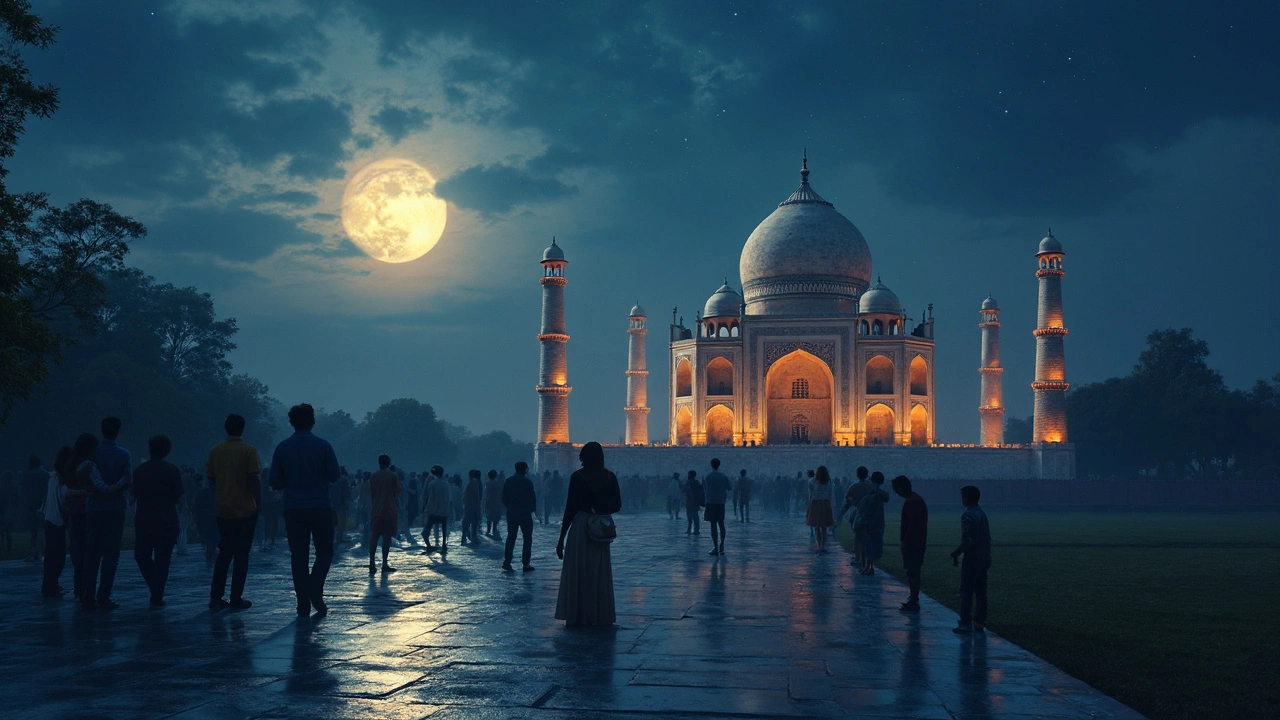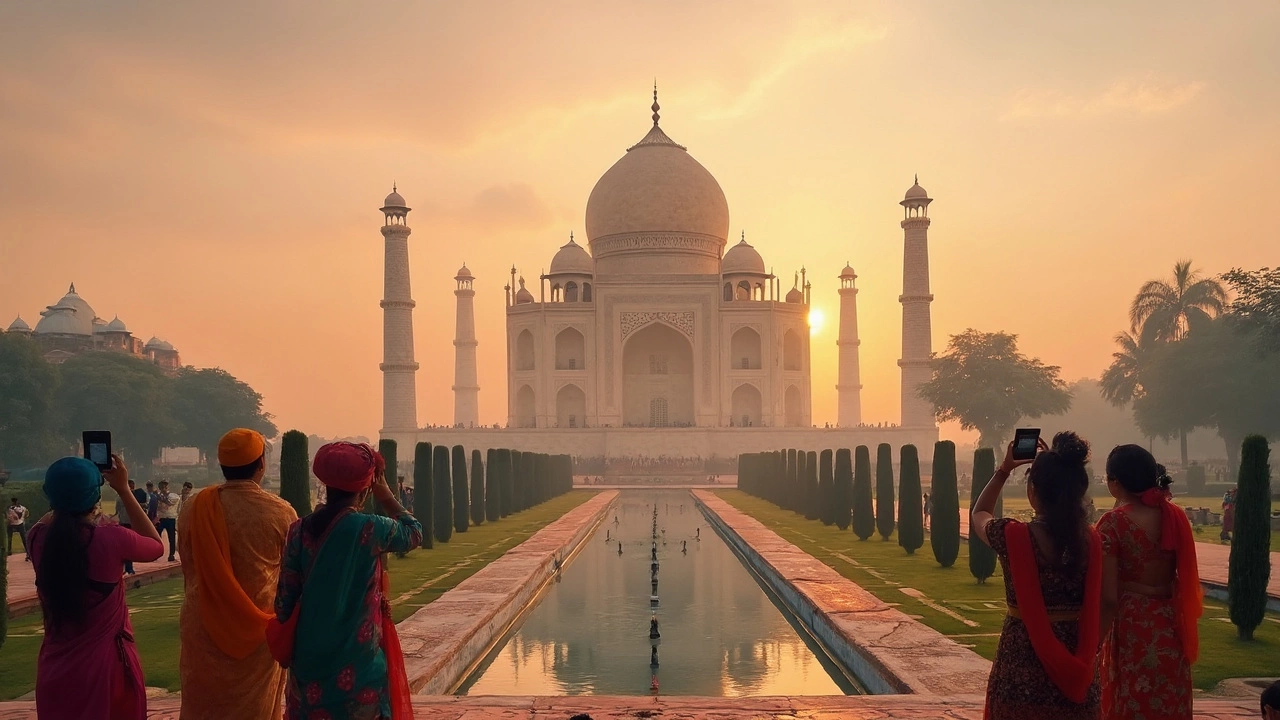So, what's the top tourist spot in India? It's got to be the Taj Mahal in Agra. This stunning white marble mausoleum stands out, not just in North India but globally. Built by Emperor Shah Jahan in memory of his wife Mumtaz Mahal, it's often dubbed as the ultimate symbol of love.
Once you're there, you'll be entranced by its beauty, especially as the sun sets and the marble changes colors. No wonder it's part of the New Seven Wonders of the World and a UNESCO World Heritage Site. The intricate carvings and symmetrical gardens make wandering about an absolute delight.
If you're planning a visit, aim for October to March when the weather's cooler. It's best to hit the monument early in the morning to avoid the crowds and catch that magical sunrise view.
- Iconic Status of the Taj Mahal
- Unique Architectural Features
- Best Times to Visit
- Helpful Travel Tips
- Historical Significance
- Must-See Spots Nearby
Iconic Status of the Taj Mahal
The mere mention of North India conjures up images of the Taj Mahal, a true icon of the country and a must-visit for any traveler. Located in the bustling city of Agra, this architectural marvel was completed in 1653 and attracts millions of visitors each year. But what makes the Taj Mahal so special?
Symbol of Love
The Taj Mahal was built by the Mughal emperor Shah Jahan as a tribute to his beloved wife Mumtaz Mahal after her death. This deep sense of devotion is what gives the monument its reputation as the most enduring symbol of love, capturing hearts worldwide.
Architectural Splendor
One can't help but admire the detailed artistry. The structure employs the finest Mughal architecture, blending Indian, Persian, and Islamic styles. Made entirely of pristine white marble, the Taj has beautiful in-laid designs with precious stones like jade, crystal, and turquoise forming complex floral patterns.
Tourist AttractionIt's no surprise that the Taj Mahal has a special place in India's tourism landscape. In 2023 alone, the site welcomed over 7 million tourists, making it the most visited monument in India. Such numbers affirm its status as a top tourist attraction not only in India but worldwide.
Preservation Efforts
To maintain its iconic beauty, several preservation efforts have been put in place. Restrictions on vehicle proximity, limited visitor numbers at times, and regular cleaning to combat pollution ensure that the Taj Mahal remains unscathed.
Experiencing the Taj Mahal firsthand is more than just a visit; it’s a journey into the heart of North India’s rich cultural and historical tapestry.
Unique Architectural Features
When you're looking at the Taj Mahal, it's not just about the overall look but the details that make it special. First off, the way it's perfectly symmetrical is jaw-dropping. Everything from the minarets to the reflecting pool has been planned with an almost obsessive attention to detail, showcasing the architectural genius of its creators.
One feature that stands out is the dome, often called the 'onion dome' due to its shape. It's like the cherry on top of this magnificent structure and measures about 35 meters in height. The marble inlay work, known as Pietra Dura, is mesmerizing. Thousands of semi-precious stones are embedded in floral patterns, making everything look like a piece of art.
Architectural Wonders of the Gateway
As you approach the Taj Mahal, you'll pass through the Great Gate. Inscribed with verses from the Quran, its walls provide a grand welcome. The clever use of calligraphy gives an illusion that the text is the same size no matter where you stand. Talk about perspective magic!
Environmental Design
Ever noticed why the Taj Mahal seems to glow? It's all about the material. Made from a special type of marble that glows in sunlight, it changes tones throughout the day. Early mornings and late afternoons are when it looks especially stunning.
Interesting Stats
| Feature | Detail |
|---|---|
| Main Dome | Approx 35 meters high |
| Minarets | 4, each more than 40 meters tall |
Every piece of this marvel comes together to highlight why it's North India's top draw. It's not just a monument; visiting is like stepping into another world where history and art continuously engage in a conversation.
Best Times to Visit
When planning your trip to see the Taj Mahal in North India, timing is key. The period between October and March is often touted as the best time to visit. Why, you ask? The weather during these months is relatively cool and pleasant, ideal for exploring the iconic site.
Visiting in the cooler months means you'll avoid the scorching heat of the Indian summer, which can climb well above 40°C (104°F). Trust me, you don't want to be sweating it out while trying to enjoy the view!
Early mornings are perfect for catching the Taj Mahal bathed in a soft, golden light. Not only does it offer a spectacular view, but morning visits are usually less crowded. Try to plan around sunrise; it adds a whole new level of beauty to your experience.
Special Viewing Days
Did you know you can catch a special view of the Taj Mahal during a full moon night? These night viewings are held two days before and after the full moon, in addition to the night itself, setting the monument aglow in a mystical light.
| Month | Average Temperature (°C) |
|---|---|
| October | 21 - 32 |
| November | 15 - 29 |
| December | 9 - 25 |
| January | 8 - 23 |
| February | 11 - 27 |
| March | 17 - 33 |
One more thing to consider: the Taj Mahal is closed on Fridays, so make sure to plan around that. Whether you're there for a sunrise, a day visit, or a magical moonlit night, knowing the best time to visit can make all the difference.

Helpful Travel Tips
Planning a trip to the Taj Mahal can be thrilling but also a bit overwhelming. Let's break it down with some practical tips that'll make your visit smoother.
Getting There
First off, getting to Agra is easy. You can take a train from Delhi, which is around 200 km away. The Gatimaan Express is super fast and takes just about two hours. If you're flying, the nearest airport is the Indira Gandhi International Airport in Delhi.
Optimal Visiting Times
The Taj Mahal is open from sunrise to sunset, except Fridays. Arriving early is your best bet to enjoy the dawn views and thinner crowds. Also, don't miss the night viewing during a full moon! It's magical and allows limited visitors, so book in advance.
Entrance Tickets and Costs
Tickets are priced differently for locals and foreign tourists, so be prepared. Payment is usually in Indian Rupees. Check online to see if there's an electronic ticketing option to save time. Kids under 15 get in free, which is a nice bonus for families.
What to Bring
Keep your backpack light. Water bottles, small snacks, a hat, and sunscreen are must-haves since you'll be outdoors a lot. Cameras are allowed, but leave your drone at home—flying them around the monument isn’t permitted.
Respectful Behavior
The Taj Mahal is not just a tourist spot; it's a UNESCO World Heritage Site and a working mausoleum. Dress conservatively and avoid loud behavior. Plastic and garbage are a big no-no; the place is kept spotless for a reason!
Pro Tip:
Before leaving, take a stroll in the nearby Mehtab Bagh for a spectacular view of the Taj Mahal from across the river. It's less crowded and offers a relaxed vibe.
Historical Significance
When it comes to North India, the Taj Mahal isn’t just an architectural wonder; it’s loaded with historical heft. Commissioned by Mughal Emperor Shah Jahan in 1632, this monument marks a pivotal era in Indian history. Built to house the tomb of his beloved wife, Mumtaz Mahal, the site blends Persian, Indian, and Islamic influences.
The Taj Mahal’s construction took over 20 years, involving 20,000 artisans from across Asia. A bit of trivia for you: it’s said Shah Jahan had plans for a black marble mausoleum opposite the Taj, but his vision never saw light due to inter-family power struggles, famously leading to his house arrest by his own son.
"The Taj Mahal rises above the banks of the river like a solitary tear suspended on the cheek of time." - Rabindranath Tagore
Considered an epitome of Mughal architecture, its aesthetic influence extends beyond India, inspiring countless structures globally. Did you know the nearby Yumana River played a vital role during its construction? Engineers used its water to stabilize the foundation, ensuring that this masterpiece withstood the test of time.
Today, the Taj stands not only as a memorial of love but also as a testament to a powerful dynasty at the peak of its glory. It’s a must-see for understanding the Mughals' profound impact on Indian culture.
Must-See Spots Nearby
While the Taj Mahal is undoubtedly the star of Agra, there's a lot more to explore in the vicinity. Let's dive into a few places that you shouldn't miss when you're there.
Agra Fort
Just a short drive away is the Agra Fort, a UNESCO World Heritage site in its own right. This massive 16th-century fortress made of red sandstone was once the main residence of the emperors of the Mughal Dynasty. Its walls are over 20 meters high and stretch about 2.5 kilometers. Take a tour to see the palaces, audience halls, and mosques inside.
Mehtab Bagh
Ever wondered how the Taj Mahal would look from across the river? Head to Mehtab Bagh for an exquisite view, especially at sunset. This garden complex was designed as an integral part of the Taj's layout and is perfect for some peaceful downtime and incredible photos.
Fatehpur Sikri
About 40 kilometers from Agra lies Fatehpur Sikri, the once glorious capital built by Emperor Akbar. Though short-lived, its grandeur remains. You can stroll through the Buland Darwaza (Gate of Victory), Jama Masjid, and the palace spaces that take you back in time.
Tomb of Itimad-ud-Daulah
Often dubbed the 'Baby Taj,' this tomb is another Mughal beauty. Commissioned by Nur Jahan for her father, this white marble mausoleum predates the Taj itself. Its intricate marble lattice screens and inlay work are truly mesmerizing.
There's a decent chance you might catch some exciting local festivals depending on when you visit. While these places give you a glimpse into the rich Mughal history, they also enhance your North India travel experience by leaps and bounds.
